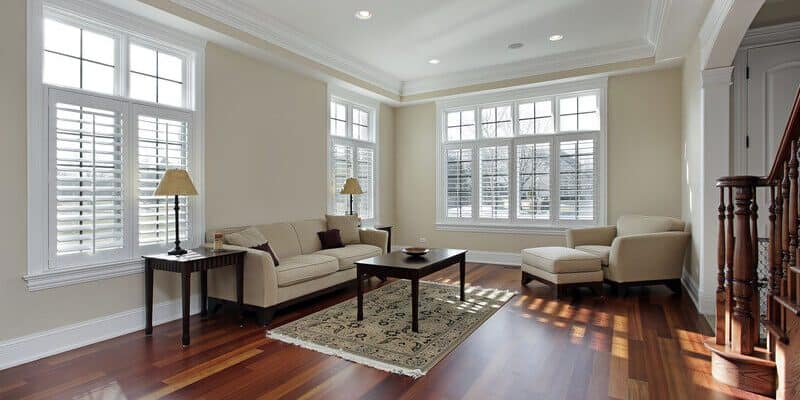As the world becomes conscious of the shared responsibility we have to protect our fragile environment, the popularity of green building practices is increasing. Sustainable flooring products are one way to both respect the natural world while improving your home’s value. Hardwood flooring is an excellent choice for sustainability when purchased from eco-conscious manufacturers, providing the highest quality floors without any compromise in style and design.
Let’s take a closer look at some of the factors behind sustainable and ecologically-friendly hardwood flooring:
1. Sustainably Harvested
When managed correctly, timber is a key renewable resource. Local and international regulations have been implemented to limit the quantity of wood that is harvested in our world’s forests. When carefully and sustainably managed, harvesting lumber can have little to no negative impact on the environment.
For each cubic foot of trees that are harvested, a median of 1.6 cubic feet is replanted. This ensures that the rate of harvest is below the median growth rate. While it takes up to sixty years for hardwood trees to mature, the current supply is sufficient to last for a minimum of 100 years, providing enough time for newly planted trees to grow and mature.
2. The Natural Choice
Wood flooring is created with natural, long-lasting materials that look great and are environmentally friendly. Hardwood floor is comprised of two components of wood, the core and the veneer. The veneer is solid hardwood harvested directly from timber. The core of engineered hardwood, however, varies depending on product and manufacturer. It may contain medium- and high-density fiberboard or plywood.
Although these materials are created via different processes, they are all in fact natural wood products. Many manufacturers utilize recycled wood pieces in their cores, reducing waste while producing a high quality and sustainable flooring solution.
3. Environmental-Friendly Stains, Finishes & Sealers
Far too many popular floor finishes, sealants, and stains contain hazardous volatile organic compounds (VOCs) and solvents such as formaldehyde and toluene. Environmentally friendly options include water-based urethanes or oil-based polyurethane, although VOCs may be present in oil-based polyurethane finishes.
There are some drawbacks to water-based urethane. For instance, they are often more expensive and have a shorter lifespan than oil-based products. Therefore, linseed oil products present an interesting eco-friendly option. It is recommended to purchase sealants that don’t contain VOC (or low in VOC) which can be ensured by avoiding products with formaldehyde.
4. Better Air Quality
5. Manufacturing Values
Irresponsible manufacturing processes require large amounts of energy and produce harmful emissions. Linoleum, carpet, and tile floorings consume tremendous energy to manufacture and utilize a long list of chemicals in their production. Wood and stone, however, are naturally formed and don’t consume much energy to produce.
Wood production doesn’t leave much waste as wood chips and sawdust are used by manufacturers to produce paper and other wood-based products. Wood can also be burned as a source of clean bio-energy. These waste management options enable wood producers to use most of each harvested tree, leaving behind mostly biodegradable waste.
6. Reusable Floorboards
Hardwoods are among the few flooring solutions that can be used multiple times for flooring and other building projects. Hardwoods can be re-stained and sanded to match an array of design plans. If the wooden flooring is too damaged to be used again, it may be repurposed as accent walls, furniture, and other decorative pieces. Reclaimed wood has increased in popularity, and many designers prefer the worn look of recycled wood.
7. Long-lasting
With proper care wood floors can last more than 100 years and can be re-stained and refinished if required. Cheaper, less sustainable flooring such as laminate and linoleum, for example, last for an estimated 15 to 25 years. Carpet has a life expectancy of eight to ten years based on traffic volume and wear and tear.
Like hardwood, stone and tile flooring can endure for 100 years but they cannot be refinished and are susceptible to cracks and staining. Hardwood, on the contrary, is highly durable and doesn’t reveal daily wear and tear as quickly as cheaper, more harmful flooring options.
Regarding pricing, linoleum and carpet are often cheaper than wood, while stone and tile are often costlier. Even though wood may not be the most affordable option at first, they are a smart long term investment since they shouldn’t require replacement within a homeowner’s entire lifetime.
Conclusion
Wood flooring has a remarkably lengthy lifespan. It can be recycled and repurposed, and is produced from one of the world’s most renewable natural resources. Little energy is consumed in their manufacture and almost no waste or chemicals are released into the environment.
Although millions of trees have been harvested around the world, we actually have more hardwood forests flourishing now than at the beginning of the twentieth century, owing to sustainable timber harvests and government regulations. And while the initial investment is perhaps larger than cheaper flooring options, hardwood floors save money in the future as they endure year after year.
With the natural and rustic look afforded by hardwood, and its contribution to a wide array of interior designs, it is no wonder that hardwood floors remain among the most popular options decade after decade.
Hardwood Floors in the Dallas Area
If you are interested in considering hardwood flooring for your home or business, we invite you to contact a representative at Dallas Floors.
We will be happy to schedule a visit to your space. We can assist in choosing the flooring best suited to your personal taste and budget, and issue a clear and transparent estimate with a customer satisfaction guarantee.













